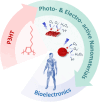Poly(3-hexylthiophene) as a versatile semiconducting polymer for cutting-edge bioelectronics
- PMID: 40331312
- PMCID: PMC12056706
- DOI: 10.1039/d5mh00096c
Poly(3-hexylthiophene) as a versatile semiconducting polymer for cutting-edge bioelectronics
Abstract
Semiconducting polymers (SPs), widely used in organic optoelectronics, are gaining interest in bioelectronics owing to their intrinsic optical properties, conductivity, biocompatibility, flexibility, and chemical tunability. Among them, poly(3-hexylthiophene) (P3HT) has attracted great attention as a versatile SP, being both optically active and conductive, for the fabrication of smart materials (e.g., films and nanoparticles), allowing the modulation of their performance and final biomedical applications. This review article provides an overview of the design of different kinds of P3HT-based materials, from chemical properties to structural engineering, to be used as key opto-electronic components in the development of opto-transducers for the modulation of cell fate, as well as biosensors such as organic electrochemical transistors (OECTs) and organic field effect transistors (OEFTs). Finally, their foremost applications in the biomedical field ranging from tissue engineering to biosensing will be discussed, including the future perspectives of P3HT derivatives towards cutting-edge applications for bioelectronics, in which optoceutics plays a key role.
Conflict of interest statement
There are no conflicts to declare.
Figures













Similar articles
-
Management of urinary stones by experts in stone disease (ESD 2025).Arch Ital Urol Androl. 2025 Jun 30;97(2):14085. doi: 10.4081/aiua.2025.14085. Epub 2025 Jun 30. Arch Ital Urol Androl. 2025. PMID: 40583613 Review.
-
Short-Term Memory Impairment.2024 Jun 8. In: StatPearls [Internet]. Treasure Island (FL): StatPearls Publishing; 2025 Jan–. 2024 Jun 8. In: StatPearls [Internet]. Treasure Island (FL): StatPearls Publishing; 2025 Jan–. PMID: 31424720 Free Books & Documents.
-
Home treatment for mental health problems: a systematic review.Health Technol Assess. 2001;5(15):1-139. doi: 10.3310/hta5150. Health Technol Assess. 2001. PMID: 11532236
-
Community and hospital-based healthcare professionals perceptions of digital advance care planning for palliative and end-of-life care: a latent class analysis.Health Soc Care Deliv Res. 2025 Jun 25:1-22. doi: 10.3310/XCGE3294. Online ahead of print. Health Soc Care Deliv Res. 2025. PMID: 40580081
-
Molecular Gridization of Organic Semiconducting π Backbones.Acc Chem Res. 2025 Jul 1;58(13):1982-1996. doi: 10.1021/acs.accounts.5c00180. Epub 2025 Jun 13. Acc Chem Res. 2025. PMID: 40512962
Cited by
-
Non-invasive action potential recordings using printed electrolyte-gated polymer field-effect transistors.Nat Commun. 2025 Aug 31;16(1):8143. doi: 10.1038/s41467-025-63484-1. Nat Commun. 2025. PMID: 40885735 Free PMC article.
References
-
- Garg S. Goel N. J. Phys. Chem. C. 2022;126:9313–9323. doi: 10.1021/acs.jpcc.2c02938. - DOI
-
- Ding B. Le V. Yu H. Wu G. Marsh A. V. Gutiérrez-Fernández E. Ramos N. Rimmele M. Martín J. Nelson J. Paterson A. F. Heeney M. Adv. Electron. Mater. 2024;10:2300580. doi: 10.1002/aelm.202300580. - DOI
-
- Gao D. Parida K. Lee P. S. Adv. Funct. Mater. 2020;30:1907184. doi: 10.1002/adfm.201907184. - DOI
Publication types
LinkOut - more resources
Full Text Sources

